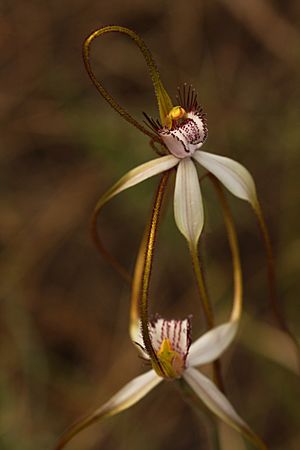Daddy-long-legs spider orchid facts for kids
Quick facts for kids Daddy-long-legs spider orchid |
|
|---|---|
 |
|
| Caladenia longicauda subsp. borealis near Eneabba | |
| Scientific classification |
|
| Kingdom: | Plantae |
| Clade: | Tracheophytes |
| Clade: | Angiosperms |
| Clade: | Monocots |
| Order: | Asparagales |
| Family: | Orchidaceae |
| Subfamily: | Orchidoideae |
| Tribe: | Diurideae |
| Genus: | Caladenia |
| Species: | |
| Subspecies: |
C. l. subsp. borealis
|
| Trinomial name | |
| Caladenia longicauda subsp. borealis Hopper & A.P.Br.
|
|
| Synonyms | |
|
Arachnorchis longicauda subsp. borealis (Hopper & A.P.Br.) D.L.Jones & M.A.Clem. |
|
The daddy-long-legs spider orchid (scientific name: Caladenia longicauda subspecies borealis) is a special plant. It belongs to the orchid family and grows only in the south-west part of Western Australia. It gets its common name because its long, thin petals and sepals look a bit like the legs of a daddy-long-legs spider! This orchid has one hairy leaf and usually one to three mostly white flowers.
Contents
About the Daddy-Long-Legs Spider Orchid
The daddy-long-legs spider orchid is a terrestrial plant. This means it grows in the ground, not on other plants. It is also a perennial herb. This means it lives for more than two years and has soft stems, not woody ones like trees.
It has an underground tuber, which is like a small storage organ. From this tuber, a single hairy leaf grows. This leaf is about 6 to 12 millimeters (about 0.2 to 0.5 inches) wide.
What the Flowers Look Like
This orchid usually grows alone, but sometimes you can find small groups of them. They flower between July and September. Each plant usually has one to three flowers on a stalk. This stalk can be quite tall, about 25 to 40 centimeters (10 to 16 inches) high.
Each flower is large, measuring about 9 to 12 centimeters (3.5 to 4.7 inches) across. The flowers are mostly white. They have some red marks and reddish stripes on the back of their petals and sepals.
- The dorsal sepal is the top part of the flower. It is green and stands upright. It is about 6 to 10 centimeters (2.4 to 3.9 inches) long and 2 to 3 millimeters (about 0.1 inch) wide. Its edges are slightly curved inwards.
- The lateral sepals are the two side parts. They are about 7 to 10 centimeters (2.8 to 3.9 inches) long and 4 to 7 millimeters (0.16 to 0.28 inches) wide. They spread out near their base but then droop downwards.
- The petals are similar to the sepals. They are about 6 to 9.5 centimeters (2.4 to 3.7 inches) long and 3 to 4 millimeters (0.12 to 0.16 inches) wide. Like the sepals, they also droop downwards.
The Labellum and Seeds
The labellum is a special lip-like part of the orchid flower. It is white and measures about 1.5 to 2 centimeters (0.6 to 0.8 inches) long and 0.7 to 1 centimeter (0.28 to 0.39 inches) wide. Along its sides, it has teeth-like parts that can be up to 1 centimeter (0.39 inches) long. The teeth in the middle part of the labellum are the longest. They are red with white tips that look like hooks. The front part of the labellum curves downwards, and its teeth become shorter.
The labellum also has small bumps called calli. There are four to eight rows of these calli along the center of the labellum. They are pale to dark red and shaped like clubs, standing up to 1.5 millimeters (about 0.06 inches) tall.
After flowering, the orchid produces a fruit. This fruit is a dry capsule that splits open when ripe. It contains many tiny seeds.
How it Was Named
In 2001, two scientists, Stephen Hopper and Andrew Brown, studied the Caladenia group of orchids. They published their findings in a science journal called Nuytsia. In their work, they described eleven different types, or subspecies, of Caladenia longicauda, including this one, borealis. Later, three more subspecies were added.
The name borealis comes from a Latin word, boreas. This word means "northern," which might refer to where this orchid is found.
Where it Lives
The daddy-long-legs spider orchid is quite common in its area. It usually grows in sandy soil that drains water well. You can find it in different types of woodlands and thickets.
- It grows in Wandoo woodlands.
- It can be found near creeks.
- It lives in groves of sheoak trees.
- It also grows in Acacia thickets.
This orchid is found between Cataby and the Murchison River in Western Australia. This area includes several biogeographic regions like the Avon Wheatbelt, Geraldton Sandplains, Jarrah Forest, and Swan Coastal Plain.
Conservation Status
The Western Australian Government Department of Parks and Wildlife has looked at the daddy-long-legs spider orchid. They have classified Caladenia longicauda subsp. borealis as "Not Threatened." This means it is not currently at risk of disappearing.

